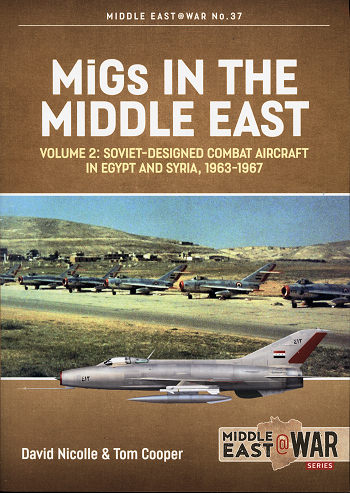 This volume
continues from the previous offering by covering the years 1063 until the start
of the 1967 war with Israel. The major focus of this time period was Egypt's war
in Yemen. This is a conflict that is not well covered in western media, but had
a major impact on the Egyptian Air Force. Specifically, it helped them to
develop tactics for fighting an insurgency, something that was not taught. In
fact, the Soviets, who supplied and trained Egypt and Syria's MiG pilots
concentrated on tactics that were generally useless for these two nations.
Specifically it was high altitude interception of enemy bombers.
This volume
continues from the previous offering by covering the years 1063 until the start
of the 1967 war with Israel. The major focus of this time period was Egypt's war
in Yemen. This is a conflict that is not well covered in western media, but had
a major impact on the Egyptian Air Force. Specifically, it helped them to
develop tactics for fighting an insurgency, something that was not taught. In
fact, the Soviets, who supplied and trained Egypt and Syria's MiG pilots
concentrated on tactics that were generally useless for these two nations.
Specifically it was high altitude interception of enemy bombers.
It was the North Yemen conflict that showed to the
Egyptians that the MiG-21 was fairly useless in this type of operation. The
MiG-17 and armed Yak-18s were far more useful. It also allowed Egypt to make use
of its IL-28 and Tu-16 bomber force, which proved to be quite effective if used
properly. In this conflict, Egypt was up against British and US supported Saudi
Arabia, who was then, as now, arming the Royalists, who has been ousted in a
coup by those wishing to establish a republic. The war had a deleterious effect
on the Egyptian economy as fighting a war meant supplying soldiers and airmen as
well as keeping equipment in the field maintained. Eventually it was this
as much as the 1967 war with Israel caused the Egyptians to withdraw. In Egypt
it is known as 'Egypt's Vietnam'.
During much of the time covered in the book, Egypt and
Syria formed the United Arab Republic (UAR), though it was in reality run by the
Egyptians. Syria was not a very stable nation and there were multiple coup
attempts and some successes that eventually caused Syria to leave the UAR. Egypt
tried to reform it but Nassar's attempts met with a lack of interest on all
fronts. The constant shifting of power and various purges were deleterious to
maintaining the Syrian Air Force.
All through this time, both Syria and Egypt continued to
purchase Soviet aircraft and equipment. Both nations needed some sort of air
defense and warning to combat the continued hostility of Israel. Syria in
particular was constantly plagued by Israel's aggression along their border,
first by occupying the DMZ between the two nations, and later by actively taking
over Syrian territory and bombing water infrastructure in the border area. Many
attempts were made by Syria to combat Israeli intrusions, but with only minimal
success. Much of the issue was with the superior equipment of Israel whose
Mirage III aircraft were too fast for Syrian MiG-17 and MiG-21 aircraft to
catch.
Meanwhile, back in Egypt, the Soviets were slowly
building up a proper air defense network which was based on the SA-2 'Guideline'
SAM system and supporting radars. As was commonplace with Soviet equipment, it
was slow in coming and equally slow in getting set up and operators trained. The
main reason for this was that factories in the Soviet Union were prioritized to
home defense requirements and so were unable to meet the rapid needs of Egypt
and Syria.
As is the norm with these books from Helion, the
research is first rate. The authors have interviewed a number of the
participants and are able to provide the sorts of insights that you cannot get
from other sources. The book has some very nice period photos as well as a
center section that includes full color profiles and illustrations. In all, it
adds to what is a superb series of histories and is a book that I can highly
recommend to you.
September 2021
Copyright ModelingMadness.com. All rights reserved. No
reproduction in part or in whole without express permission.
Review book courtesy of
Casemate Publishing, where you can order your copy
at this
link.
If you would like your product reviewed fairly and
fairly quickly, please
contact
the editor or see other details in the
Note to
Contributors.
 This volume
continues from the previous offering by covering the years 1063 until the start
of the 1967 war with Israel. The major focus of this time period was Egypt's war
in Yemen. This is a conflict that is not well covered in western media, but had
a major impact on the Egyptian Air Force. Specifically, it helped them to
develop tactics for fighting an insurgency, something that was not taught. In
fact, the Soviets, who supplied and trained Egypt and Syria's MiG pilots
concentrated on tactics that were generally useless for these two nations.
Specifically it was high altitude interception of enemy bombers.
This volume
continues from the previous offering by covering the years 1063 until the start
of the 1967 war with Israel. The major focus of this time period was Egypt's war
in Yemen. This is a conflict that is not well covered in western media, but had
a major impact on the Egyptian Air Force. Specifically, it helped them to
develop tactics for fighting an insurgency, something that was not taught. In
fact, the Soviets, who supplied and trained Egypt and Syria's MiG pilots
concentrated on tactics that were generally useless for these two nations.
Specifically it was high altitude interception of enemy bombers.